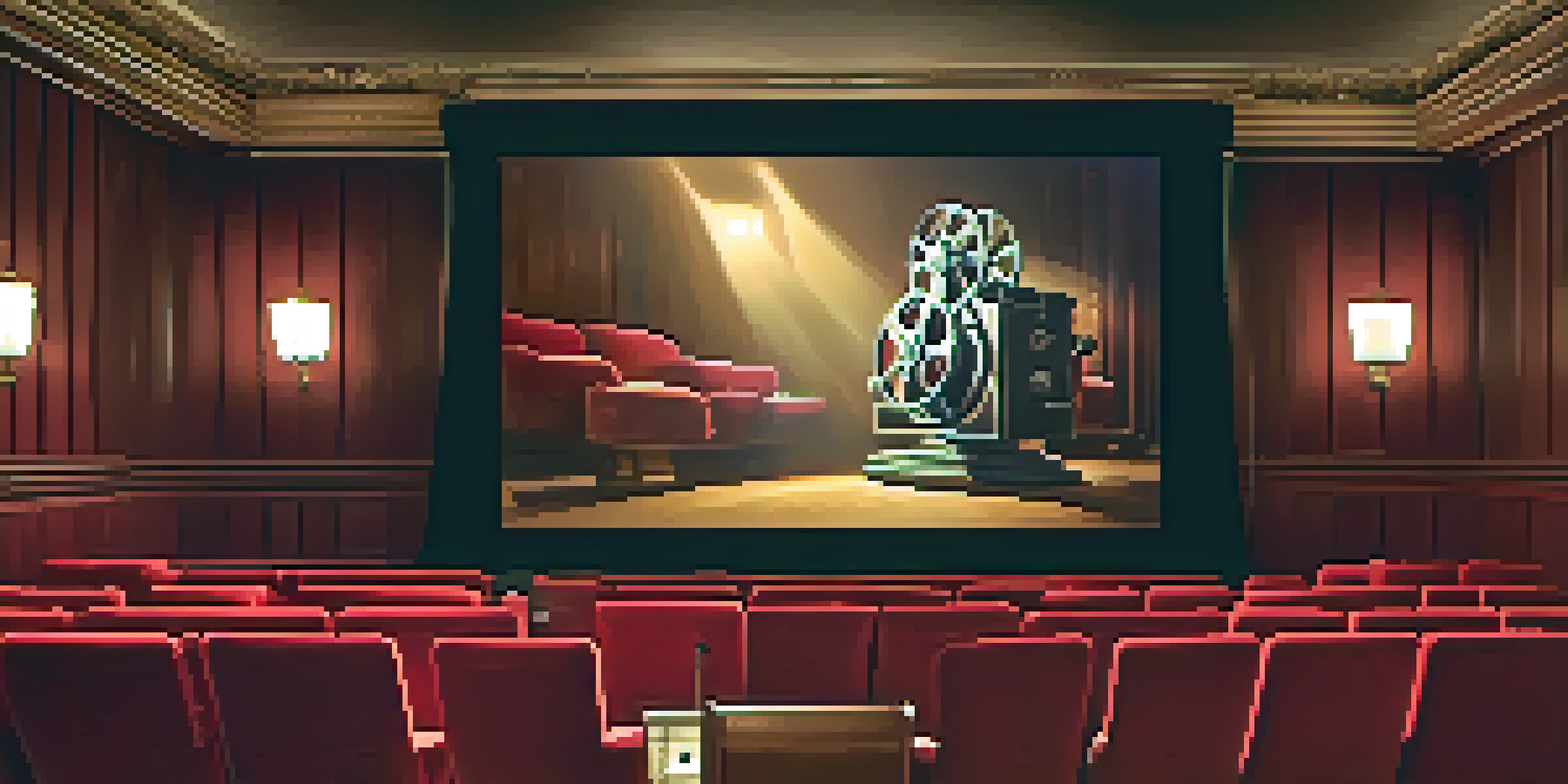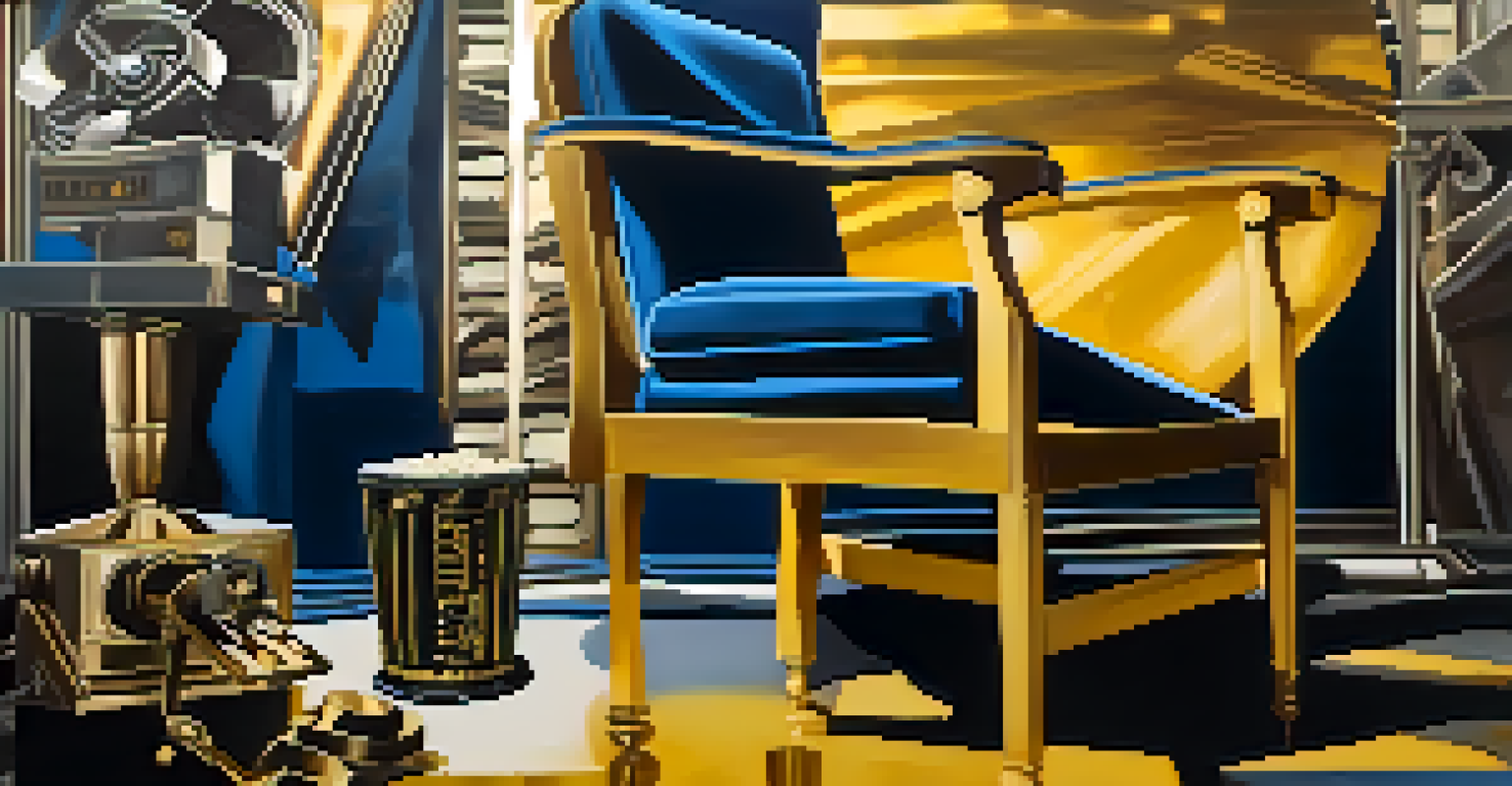The Golden Age of Hollywood: Trailers as Art Forms

Introduction to the Golden Age of Hollywood
The Golden Age of Hollywood, spanning from the late 1920s to the early 1960s, marked a transformative era in cinema. It was during this time that movies became a primary source of entertainment, captivating audiences with their storytelling and visuals. The industry's growth was paralleled by advancements in technology, which allowed for richer narratives and more compelling cinematic experiences.
Film is a powerful means of communication and a mirror reflecting society's hopes and fears.
As films gained popularity, studios recognized the importance of marketing their products effectively. This led to the evolution of trailers, which began as simple previews of upcoming films but soon became a vital part of a movie's identity. They not only showcased the film's plot but also set the tone, enticing viewers to purchase tickets and experience the magic on the big screen.
Trailers from this era are often regarded as art forms in themselves, blending visual storytelling with innovative editing techniques. They serve as a fascinating window into the cultural landscape of the time, reflecting societal values and the cinematic trends that shaped Hollywood's legacy.
The Evolution of Film Trailers
Initially, trailers were quite different from what we see today. Often, they were little more than a brief montage of scenes, lacking the narrative flair that would later define them. However, as filmmakers began to understand the impact of trailers on audience engagement, they started to experiment with various styles and formats, leading to more creative approaches.

By the 1940s and 1950s, trailers began to incorporate voiceovers, dramatic music, and engaging graphics. This transformation allowed studios to tell a more compelling story in just a few minutes, making the trailers themselves miniature films. The impact was profound; audiences were drawn in by the emotional resonance and cinematic techniques employed in these short pieces.
Trailers as Art Forms
Golden Age trailers evolved into artistic expressions, employing innovative techniques that captivated audiences and showcased cinematic storytelling.
As a result, trailers started to gain recognition not just as promotional tools but as significant artistic expressions. They paved the way for a new genre of storytelling, one that valued brevity while still conveying depth and excitement.
Iconic Trailers of the Golden Age
Some trailers from the Golden Age have become legendary, remembered for their creativity and impact. For instance, the trailer for Alfred Hitchcock's 'Psycho' is often cited as a classic example of how to build suspense and intrigue. Hitchcock himself was heavily involved in the trailer's creation, using it as a means to enhance the film's psychological horror elements.
The art of storytelling is timeless, transcending the boundaries of time and technology.
Another noteworthy example is the trailer for 'Gone with the Wind,' which artfully combined stunning visuals with a stirring narrative. This trailer not only highlighted the film's epic scope but also captured the essence of its characters and themes, drawing audiences into the world of Scarlett O'Hara.
These iconic trailers are not merely promotional pieces; they are cultural artifacts that encapsulate the spirit of their time. They reflect the artistic aspirations of their creators while also resonating with audiences on a deeper level, showcasing the power of film as a medium.
The Role of Music in Trailers
Music plays a crucial role in establishing the emotional tone of a trailer. During the Golden Age, composers began to recognize the impact their scores could have on audience perception, and this realization influenced trailer production significantly. The right music can elevate a trailer, transforming it from a simple preview into a captivating experience.
For example, the haunting score of 'Jaws' not only set the mood for the film but also became a defining element of its trailer. The iconic two-note motif created an atmosphere of suspense and fear, compelling viewers to anticipate the thrill of the movie itself. Similarly, elaborate orchestrations were often used to convey the grandeur of epic films, enhancing their appeal.
Cultural Reflections in Cinema
Trailers from this era mirrored societal values and themes, connecting deeply with audiences and reflecting the cultural landscape of the time.
By expertly weaving music into trailers, filmmakers were able to evoke emotions and build anticipation in ways that visuals alone could not achieve. This practice continues to be a key element in trailer production today, showcasing the lasting legacy of the Golden Age.
Editing Techniques that Shaped Trailers
The editing of trailers has evolved dramatically over the years, especially during the Golden Age of Hollywood. Early trailers often relied on straightforward, linear editing, but as filmmakers began to experiment with pacing and rhythm, they discovered the power of juxtaposition. This led to the development of more dynamic editing techniques that could evoke specific emotions.
For instance, rapid cuts and transitions became popular as they created a sense of urgency and excitement, effectively drawing audiences into the story. Trailers like that of 'The Wizard of Oz' utilized this technique, seamlessly transitioning between scenes to showcase both the fantastical elements and the emotional depth of the film.
These editing techniques not only transformed trailers into engaging pieces of art but also influenced how audiences experienced films overall. The way a trailer is edited can significantly impact its effectiveness, demonstrating the importance of craftsmanship in the art of storytelling.
Cultural Reflections in Trailers
Trailers from the Golden Age often served as cultural barometers, reflecting societal values and concerns. They provided a glimpse into the themes that resonated with audiences at the time, whether it was romance, adventure, or social issues. This connection between film and culture is what makes trailers such compelling artifacts of history.
For example, films like 'Casablanca' and their trailers highlighted themes of sacrifice and love during a tumultuous period in history. The trailers not only captured the essence of the films but also tapped into the collective consciousness of the audience, making them feel seen and understood.
Legacy of Golden Age Techniques
The innovative approaches established during the Golden Age continue to influence modern trailer production, emphasizing emotional resonance and storytelling.
In this way, trailers became more than just promotional materials; they were mirrors reflecting the hopes and fears of society. This cultural relevance is a testament to the power of cinema as a means of communication and connection.
Legacy of Golden Age Trailers in Modern Film
The impact of Golden Age trailers continues to be felt in today's film industry. Modern trailers often draw inspiration from the innovative techniques and artistic approaches established during this era. Filmmakers and marketers alike understand the importance of creating engaging, emotionally resonant trailers that can capture the attention of a diverse audience.
As we see today, trailers are often crafted as standalone pieces of art, incorporating elements like storytelling, music, and visual effects. The influence of classic trailers can be seen in the way modern studios approach marketing, often turning trailers into events in their own right, complete with teasers and countdowns.

Ultimately, the legacy of Golden Age Hollywood trailers reminds us that even in a world dominated by digital media and instant gratification, the art of storytelling remains timeless. As we continue to evolve, the lessons learned from this golden era will undoubtedly shape the future of film and its promotion.